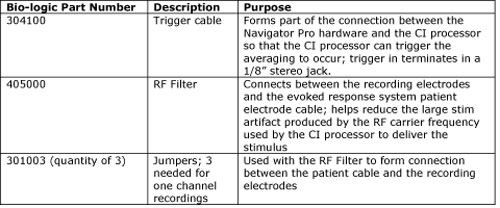Question
I work with patients who have cochlear implants. The physician with whom I work wants to begin performing Electrical ABRs post-implantation. How do I use my evoked potential system for EABR testing?
Answer
For Electrical ABR testing, your evoked response system acts as the response averager. The cochlear implant processor delivers the electrical pulse to the implant and simultaneously triggers the evoked response system to collect epochs of data from the recording electrodes.
Hardware
For your Bio-logic Navigator Pro ABR system to function as the averager for EABRs, there are a few non-standard hardware components that are required.

You also are likely to need an adapter that will serve to match the connections between the Bio-logic trigger in cable and the trigger out connector on your cochlear implant processor. The Bio-logic trigger in cable terminates in a 1/8" stereo jack. The trigger out connector on the implant processor is different for the various manufacturers. You can look on the implant processor or contact the manufacturer to determine the type of connector for the trigger out on their device. Bio-logic does not supply these intermediary components but they are readily available in an electronics supply store.
Bio-logic Navigator Pro AEP Protocol Parameters
The data collection protocol for EABR will require some parameter changes from your standard click-evoked ABR protocol. Below are guidelines for EABR parameter settings as a starting point. Of course, there are no clearly defined standards for setting of these parameters and other settings may also work or be desirable for your testing purposes.
Montage
The typical electrode placement for EABR is:
Non-inverting = Cz or high foreheadRecording parameters
Inverting = Mastoid or earlobe contralateral to the implant
Ground = Low forehead
Epoch or analysis window = 5.33 msStimulus parameters (since the implant processor provides the stimulation most settings in the Bio-logic AEP system Stimulus setup tab are irrelevant. However the following parameters should be set:
Data points = 256 points
Pre/post time = 0 ms
Blocking = 0.7 ms
Max # averages = set to 100 less than the implant processor is set to deliver; eg. If processor is set to 1000, set Navigator Pro protocol to 900.
Insert delay = 0.0 msAmplifier parameters
Trigger in = enabled
Channels = 1 enabledCochlear Implant Processor Stimulus Parameters
Gain = 50,000
Artifact rejection = disabled
Electrode switching = disabled
Low Filter (ie high pass) = 100 Hz
High Filter (ie low pass) = 3000 Hz
Since the CI Processor provides the electrical stimulus, these parameters must be set via the implant software. Consult with your CI manufacturer rep for suggestions regarding setup of the electrical stimulus parameters.
Tips & Tricks
Be sure to initiate the stimulus from the implant processor prior to starting the recording of the average on the Navigator Pro system. This will help avoid a situation in which the Navigator Pro times out because no trigger pulse is received, resulting in display of an error message in the AEP software.
EABR Responses
A typical EABR waveform shows a IV/V complex peak occurring around 4.5 ms in latency. It is generally no larger than 1 microvolt in amplitude. Any "response" that is unusually large may reflect EMG caused by facial nerve stimulation and should be viewed with suspicion.
EABRs obtained from the apical electrodes of the implant generally produce the largest amplitudes, the best morphology and the lowest thresholds. EABR amplitude and latency are affected by the intensity of the electrical stimulation just like standard ABR latency and amplitude are impacted by the intensity of the acoustic stimulus.
Information needed from the Cochlear Implant Manufacturer
Not all cochlear implants processors are designed to support EABR testing. You will need to confer with your CI manufacturer representative to determine whether EABRs are feasible with the combination of CI hardware and software that you use.
Also contact the CI manufacturer for details about the interface connection into the CI processor so you can obtain the correct adapter for connecting the CI processor trigger out to Bio-logic's trigger in cable.
Visit www.bio-logic.com for more information or the Bio-logic Web Channel on Audiology Online at www.audiologyonline.com/channels/bio-logic.asp
Shannon White, Au.D., FAAA - Clinical Education Consultant, Bio-logic Systems and Natus Medical, Inc. Prior to coming to Bio-logic and Natus, Shannon worked in a non-profit audiology clinic performing diagnostic evaluations as well as fitting amplification on both pediatric and adult patients. She received her Master's degree from California State University Sacramento and her Doctorate from the University of Florida. Prior to becoming an audiologist she worked as a hearing health educator, teaching hearing conservation to over 13,000 children.